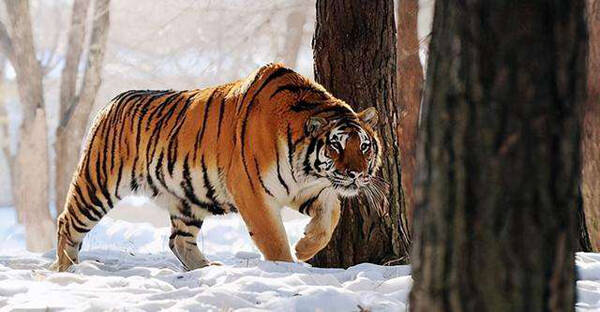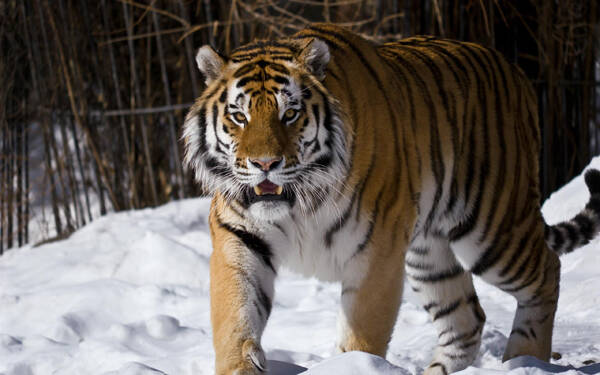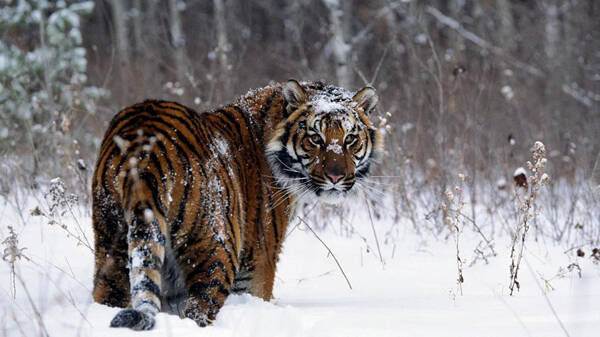Panthera tigris ssp. altaica
IUCN
LCBasic Information
Scientific classification
- name:Panthera tigris ssp. altaica
- Scientific Name:Panthera tigris ssp. altaica, Amur Tiger、Altaic Tiger、Korean Tiger、North Chinese Tiger、Ussuri Tiger, Tigre de Sibérie,Tigr,Siberian tiger, Manchurian tiger, Korean tiger, Amur tiger
- Outline:Carnivora
- Family:Schizopoda Felidae Panthera
Vital signs
- length:About 2-2.3 meters
- Weight:170-250kg
- lifetime:20-25years
Feature
The largest cat on earth
Distribution and Habitat
Russian Far East: Mainly distributed in the Sikhote-Alin Mountains that run through the Khabarovsk Territory and the Primorsky Territory. There is also a small population that is basically isolated from the large population and distributed in the southwest of the Primorsky Territory, but it is connected to the population in Jilin, China.
Northeast China: Except for the occasional cross-border individuals entering from the north of Heilongjiang, most of China's Siberian tigers are distributed in the Changbai Mountain system, that is, the eastern Jilin Province and the eastern Heilongjiang Province. In Jilin Province, they are mainly distributed in Wangqing, Hunchun, Dunhua and other places in Yanbian Prefecture; in Heilongjiang Province, they are mainly distributed in the eastern forest area of Wandashan.
Mountainous areas in northern North Korea: There may be a small number of Siberian tigers distributed, but the specific situation is not clear due to the lack of field sur
Appearance
The average weight of an adult male Siberian tiger is 250 kg, and the head and body length is about 2.3 meters; the average weight of an adult female tiger is about 170 kg, the body length is about 2 meters, the shoulder height is about 1.1 meters, and the tail length is about 1.3 meters. The maximum body length can reach 2.9 meters (including the tail length). The head is large and round, with several black horizontal stripes on the forehead, which are often connected in the middle, very similar to the word "king", so it is known as the "king of the jungle" and "king of all beasts". The ears are short and round, the back is black, and there is a white spot in the center. Its fur color is bright, with brownish yellow in summer and light yellow in winter. The back and sides of the body are light yellow, the belly is white, and there are many horizontal black narrow stripes on the back and sides of the body, usually 2 close together in the shape of willow le
Details
The Siberian tiger (scientific name: Panthera tigris ssp. altaica) is a subspecies of tiger. It is the largest cat species. Its name, like other tigers, comes from where it once roamed. 100 years ago, the species was active in a wide range of Siberia, the Russian Far East, Northeast China and South Korea. Today, 95% of the world's last Siberian tigers live in the Russian Far East, where the Heilongjiang River borders China. The Heilongjiang River is called "Amur River" in Russian, so they have become more commonly known as "Amur Tigers". It is estimated that as of 2010, a small group of more than 20 Siberian tigers live in Northeast China. The subspecies identification of the Siberian tiger is confirmed based on molecular markers. The low level of genetic variation in this subspecies may be due to past and recent population declines (Luo et al., 2004, Henry et al., 2009).

The Siberian tiger often moves alone and has a fixed territory, marking the boundaries of the territory by spraying urine and hanging claws. The territorial edges of males and females overlap, and males and females live together during the breeding season. Females generally range from 300-500 square kilometers, while males generally range from 500-1000 square kilometers.
The endangered Siberian tiger is a top predator of cold climates. In areas of distribution with deep snow, their primary habitat is covered with twelve to twenty inches of snow (30-50 cm deep) for four months of the year. Temperatures can drop as low as -40°C. To survive these cold winters, Siberian tigers have thicker fur than southern tiger subspecies, especially with some short manes around their paws and necks. Their fur ranges from orange to brown and changes with the seasons. Their thick fur turns pale in the winter to blend in with the snow, and nearly doubles in length to help them better camouflage themselves in the snow and keep warm. In the summer, their fur becomes thinner and darker, preparing them for excellent ambushes in dense woods.
Siberian tigers are not only good at crossing deep snow, but also excellent swimmers. They prefer to keep their territory close to water. Due to the relatively low density of prey in cold habitats, they have a larger range of activities than other tiger subspecies and will travel long distances to find prey. The Siberian tiger's hunting method is to lie in wait or sneak to a certain distance, then suddenly attack, hold the prey, and then bite the throat or mouth and nose of the captured animal to suffocate the prey.
Red deer and wild boar, two large ungulates, account for more than 80% of the Siberian tiger's diet, while small and medium-sized ungulates such as sika deer and Siberian roe deer account for a small proportion of the Siberian tiger's diet. This is because the Siberian tiger is so large that if it preys on small prey, the meat provided by the small prey is not enough to make up for the physical energy consumed in chasing them, so it is not cost-effective for the Siberian tiger. Interestingly, bears also account for 2-3% of the diet of Siberian tigers; Siberian tigers often prey on black bears and even attack hibernating brown bears.

Siberian tigers mate in winter, which is generally from November to February of the following year. During the estrus period, the tiger's call is particularly loud and can reach 2 kilometers away. The gestation period is about 105-110 days, and 2-4 cubs are born each time, usually 2 cubs. The newborn cubs weigh about 1 kg. The lactation period is 5-6 months. The mother tiger and the cubs live together for 2-3 years. During this period, the female tiger does not estrus and mate. Therefore, under natural conditions, the female tiger can only reproduce once every 2-3 years. Female tigers are sexually mature at the age of 3, and male tigers are later, about the same age or one year later. The life span of a tiger is generally 20-25 years.
During the estrus period, when the female Siberian tiger is ready to mate, it will attract male tigers by roaring and spraying "marking fluid". The male smells and hears the female's call, and looks for the female tiger in the hope of mating. If several male tigers approach, a bloody battle is likely to occur. The winning male has another situation to deal with: the "capricious" behavior of the female. The female tiger, who was eager the moment before and rolled in front of the male tiger, will immediately become irritable and hit the male tiger after mating. Since the male tiger needs to be accepted by the female tiger, he will not retaliate, but patiently woo the female tiger. About three and a half months after mating, the female is ready to give birth. Before the activity, she will find a sheltered place - a cave, a dense bush or a depression in the dense grass. There, the female tiger gave birth to her cubs, and the average number of cubs per litter is 3. Tiger cubs are small, weighing only 900-1360 grams each. The cubs stay near the den for the first few weeks after birth, but when they are two months old, they begin to follow their mother to find food. In the following months, the cubs learn to improve themselves through imitation and practice. They become independent at one and a half to two years old.
Tigers are part of the natural heritage of the human planet and a symbol of the earth's biodiversity. They are a keystone species, vital to the integrity of the ecosystems in which they live. As top predators, they keep prey populations in check, thus maintaining a balance between herbivores and the vegetation they depend on. Simply put, when tigers thrive, the entire ecosystem thrives. This, in turn, provides important economic, cultural and spiritual benefits to local communities that live with or near tigers.

Since the 1930s, the Siberian tiger population in the Russian Far East has dropped to 20-30 individuals. According to a comprehensive population survey in 2005, by 2010, it was estimated that only 360 Siberian tigers remained in Russia. And 13 years of monitoring data show a significant decline in population, with a more pronounced decline since 2004, although tiger numbers rebounded in 2010. Poaching of tigers and their wild prey is believed to be the cause of the decline. In addition, extensive genetic sampling of 95 wild Siberian tigers found significantly lower genetic diversity and extremely low effective population size (Ne) compared to the census population size (N) (Henry et al. 2009). This suggests a population bottleneck in the 1940s and is consistent with low cub survival rates documented in the Russian Far East, and the population in the Sikhote-Alin Mountains is isolated from the Primorsky Krai population in the south by human activities. In China, there are too few breeding resident female tigers to form their own sustainable population, relying on continued recruitment of cross-border individuals from Russia. The status of the North Korean population is uncertain.
The number of Siberian tigers was estimated at 500 in 2010. Among them, 20 tigers are regularly found on the border of Jilin Province and Heilongjiang Province in China. According to data from the Northeast Tiger and Leopard National Park Administration in October 2021, the number of wild Siberian tigers recorded in the Northeast Tiger and Leopard National Park has increased from 27 at the beginning of the pilot in 2017 to 50, and more than 10 newly bred cubs have been monitored. On December 7, 2021, the Barengou Forest Farm of the Tianqiaoling Forestry Bureau of Jilin recently reported to the Tianqiaoling Bureau of the Northeast Tiger and Leopard National Park Administration and the Xiangshui Police Station of the Tianqiaoling Forest Public Security Bureau that it was suspected that Siberian tiger footprints were found in the jurisdiction. After professional identification by animal protection staff, it was confirmed to be wild Siberian tiger footprints. In 2022, the number of wild Siberian tigers in the Northeast Tiger and Leopard National Park exceeded 50. In April 2022, it was learned from Wangqing County, Yanbian Korean Autonomous Prefecture, Jilin Province that on the evening of the 21st, the government staff of Fuxing Town in the county encountered a wild Siberian tiger on the way back from the countryside.

Main endangered factors of the Siberian tiger: 1. Habitat destruction and poaching have led to the extinction of large prey such as red deer that it relies on. 2. Direct poaching of tigers in Russia and accidental injuries to tigers by a large number of hunting snares that have not been cleared in China. 3. Due to human activities, habitat destruction and other factors, the distribution area of the Siberian tiger has been divided into multiple isolated "islands", lacking genetic exchange between distribution areas, and even some distribution areas have only one individual and cannot reproduce.
Listed in the "Red List of Endangered Species of the World Conservation Union" (IUCN) 2010 ver3.1-Endangered (EN).
Listed in Appendix I, Appendix II and Appendix III of the Convention on International Trade in Endangered Species of Wild Fauna and Flora (CITES) 2019 Edition Appendix II.
Listed in the first level of China's "National Key Protected Wildlife List" (February 5, 2021).
Protect wild animals and stop eating game.
Maintaining ecological balance is everyone's responsibility!








